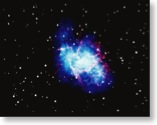Supernovas
(This article has been reproduced from the Center for Scientific Creation. The original article can be found here.)In galaxies similar to our Milky Way Galaxy, a star will explode violently every 26 years or so:
“An application of the present results to the [Milky Way] Galaxy yields one supernova per 26 (± 10 estimated error) years in very good agreement with the evidence from historical supernovae.” G. A. Tammann, “On the Frequency of Supernovae as a Function of the Integral Properties of Intermediate and Late Type Spiral Galaxies,” Astronomy and Astrophysics, Vol. 8, October 1970, p. 458.
These explosions, called supernovas, produce gas and dust that expand outward thousands of miles per second. With radio telescopes, these remnants in our galaxy should be visible for a million years. However, only about 7,000 years’ worth of supernova debris are seen (Keith Davies, “Distribution of Supernova Remnants in the Galaxy,” Proceedings of the Third International Conference on Creationism (Pittsburgh, Pennsylvania: Creation Science Fellowship, Inc., 1994), pp. 175–184.). So, the Milky Way looks young.
The Crab Nebula. In A.D. 1054, Chinese observers (and perhaps Anasazi Indians in New Mexico and Arizona) witnessed and described a supernova. It was visible in daylight for 23 days and briefly was as bright as a full moon. Today, the debris (or remnants) from that explosion comprise the Crab Nebula.
Thanks to radio telescopes, most of these remnants should be visible for a million years. At the rate supernovas are occurring in galaxies like ours, we have only about 7,000 years’ worth of remnants.
----------
(This article was taken from the book, In the Beginning by Dr. Walt Brown. The book can be purchased from the Center for Scientific Creation. The original article can be found online here. For more information about Dr. Walt Brown, click here).
